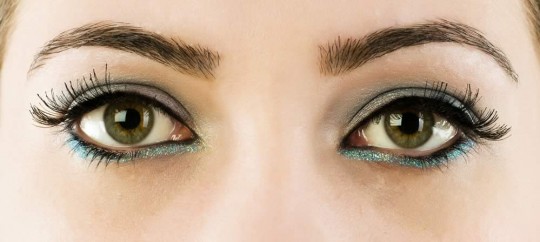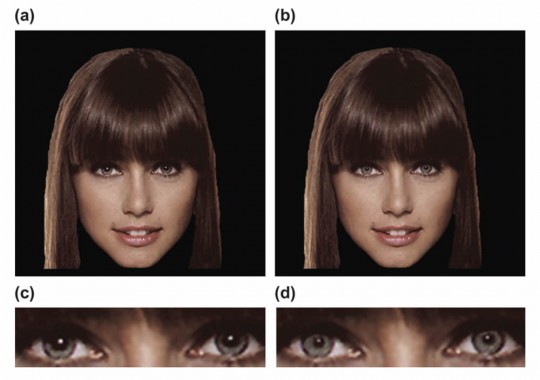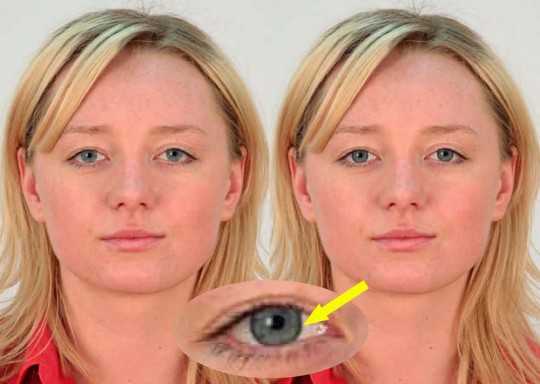Eyes Are The Door to Trust. Attractiveness, Too.
Shakespeare told us that “eyes are the window to our soul,” and, as with many things, the Bard had keen insight. A variety of studies have shown us that specific eye characteristics affect how much we trust or like someone. This isn’t just true in person, but even when we view the person via print or digital media.

The most recent study had subjects play a “trust game” with a virtual partner. The pupils of the face on the screen were digitally modified to dilate (get bigger), stay the same, or constrict.
Trust was significantly greater for the virtual partners with dilating pupils and lower for those with constricting pupils. The scientists also observed mimicry, i.e., the subjects’ pupils responded to their partner by mimicking the pupil condition they were seeing.
Very small changes to eyes in photos increase #trust and attractiveness pic.twitter.com/3S0deJMSEv Share on XThere’s other research showing the importance of dilated pupils. Decades ago, White and Maltzman demonstrated that when we are interested in something, our pupils get bigger.
An earlier study suggested that dilated pupils indicated sexual arousal, although it’s possible that the dilation was triggered more by interest in the subject matter than actual arousal.

More recently, Dartmouth researchers used fMRI to determine that our brain’s amygdala responds to larger pupils. The amygdala is a brain structure associated with emotions, fear, and pleasure.
The Dartmouth scientists also found, unsurprisingly, that the subjects were not aware of their response or even that there were variations in pupil size in the images they saw.
Don Draper’s Neuromarketing?
We think of neuromarketing as a recent development, but advertisers have been trying to gauge the subconscious reactions of consumers for many years. The Mad Men series may have just missed Don Draper, or at least his agency research people, turning to biometric measurements. In the 1970s, pupillometry was used as a means of evaluating how consumers reacted to ads.
These early neuromarketers ran into a problem similar to that facing their counterparts of today. While emotional responses can be detected and even quantified, it’s more difficult to determine exactly what emotion the subject is experiencing. Is she aroused or disgusted? Amused or angered?
Add to that the challenge of predicting buying behavior from the uncertain emotion and you can see why pupillometry was mostly abandoned.
Even today, though, pupil dilation is cited as one of many biometric measures available to neuromarketers. It’s relatively easy to measure, and its predictive power may be enhanced by combining it with other streams of biometric or brain activity data.
Your Eyes Are The Door to Trust. Attractiveness, Too. #Neuromarketing pic.twitter.com/NV03KD6KlZ Share on XIn-person pupil control?
How can you apply this knowledge?
For in-person contact, your options for sending trust signals via pupil dilation are limited. Even though you might like to enlarge your pupils as you interact with others, pupil size variations are an involuntary response.
I have heard suggestions that one could concentrate intently on something, an activity known to dilate pupils. But, if you are trying to solve complex math problems simultaneously with having a conversation, the results will almost certainly be bad.
You probably don’t want to use those horrible drops your eye doctor uses to chemically dilate your pupils. The people you meet might wonder why you seem to be unfocused and visually challenged.
You could always try contacts that simulate dilated pupils or even max them out. Then again, you might end up looking like you stepped out of an anime cartoon.
Probably the best bet is to maintain eye contact with the person you are talking to and hope your pupils automatically mimic what they see. Mutual dilation will likely lead to greater trust.
Do photo shoots decrease trustworthiness?
In a typical photo or video shoot, what do you have? Usually, lots of light. Bright lights. And, even if you can avoid squinting, those bright lights will cause you (or your model’s) pupils to get smaller.
One solution is to keep the ambient studio lighting fairly dark so that the pupils stay reasonably dilated. For still photos, the flash duration will be short enough to capture the image before the pupils shrink in response.
Of course, you may be working with existing images or stock photos. Fortunately, it’s fairly easy for a photo retoucher to change pupil size after the fact. Most of the scientific experiments looking into pupil size use exactly that technique.
If the subject of a photo is representing you or your brand, it would be worth a moment to check for tiny pupils. A re-shoot or even a subtle retouching effort might pay off in higher likability and trust levels.
Don’t Forget Your Limbal Ring…
The seductive pull of large pupils has been commonly known for years.
But, it turns out there’s another eye characteristic that makes one attractive – a more prominent limbal ring. The limbal ring is the perimeter of the iris and forms the boundary with the “white” of the eye.
A study at UC Irvine found that subjects of both sexes found an opposite-gender image more attractive when the eyes had thicker limbal rings.

In the illustration above (used in the UC study), male viewers preferred the face image on the right.
Since the limbal ring tends to get less prominent as we age, the researchers concluded that a thicker ring was a marker for youth and health.
There’s not a lot you can do about your own limbal ring. Some cosmetic contact lenses do simulate a thicker, darker ring. For most of us, though, that might seem like a rather extreme solution.
2 changes to your online photo increase your #trust and attractiveness pic.twitter.com/NV03KD6KlZ Share on XOnce again, retouching may be the answer. As with your beady, pin-point pupils, your Photoshop pro can take care of an inadequate limbal ring with little difficulty. While she’s removing skin imperfections and giving you a Hollywood-quality smile, have her darken your limbal ring. That might do as much for for your apparent youth and vigor as the other tweaks!
